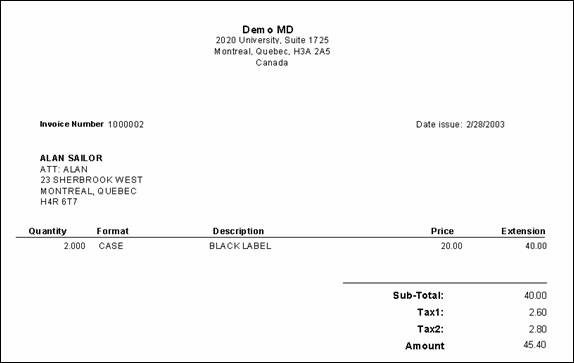
Loading...
Loading...
Loading...
Loading...
Loading...
Loading...
Loading...
Loading...
Loading...
Loading...
Loading...
Loading...
Loading...
Loading...
Loading...
Loading...
Loading...
Loading...
Loading...
Loading...
Loading...
Loading...
Loading...
Loading...
Loading...
Loading...
Loading...
Loading...
Maitre'D's items waste history report shows you the history of inventory items wastes that affected the inventory quantities according to your specifications. From the report filter window, select the dates, locations, items, categories and groups to be included in the report. The following is a sample of the items waste history report:
For each location, this report is divided in two parts. The first line provides you with:
Date:
Date the inventory items were wasted.
The second part provides you with:
Code:
Inventory item code.
Product:
Inventory item description.
Quantity:
Number of inventory items wasted.
Unit:
Inventory format
Cost:
Price worth per inventory format.
Total:
Total value wasted.
Maitre'D's purchase order report allows to print a previously created purchase order so it can be mailed, faxed or read over the phone to the supplier. From the report filter window, select the dates, suppliers, locations, items and categories to be included in the report. The following is a sample of the purchase order report:
This report is divided in two sections. The first section provides you with:
>Billing address
Address where the invoice will be mailed.
>Purchase Order
Date:
Date of creation of the purchase.
P.O.#:
Purchase order sequential number.
Maitre'D's undelivered items report shows you a summary of the backorder items according to your specifications. From the report filter window, select the dates, suppliers, locations, items and categories to be included in the report. The following is a sample of the undelivered items report:
For each supplier, this report is divided in three parts. The first line provides you with:
Supplier:
Name of the supplier.
Contact:
Contact information of the supplier.
>
The second line provides you with:
Date:
Address of supplier for this purchase.
Ship To:
Address where the merchandise will be shipped.
The second section provides you with:
Quantity:
Quantity of items ordered.
Unit:
Format of items ordered.
Code:
Code of the inventory item.
Description:
Inventory item description.
Price:
Price paid by purchase format.
Amount:
Total $ amount of the ordered item.
Total:
Total $ amount of all items on the purchase order.
P.O.#:
Purchase order sequential number.
The third part provides you with:
Order:
Quantity of items ordered.
Recev:
Quantity of items received.
Missing:
Quantity of items missing.
Item:
Inventory item description.
Undelivered reason:
Explanation of backorder.
Maitre'D's history report shows you the history of actions that affected the inventory quantities according to your specifications. From the report filter window, select the dates, locations, items, categories and groups to be included in the report. The following is a sample of the history report:
For each location, this report is divided in two parts. The first line provides you with:
Date:
Date the action occurred.
The second part provides you with:
Type:
Type of action that affected the inventory. Possible types include adjustments, productions, purchases, inventory items waste and sales items waste.
Code:
Inventory item code.
Product:
Inventory item description.
Quantity:
Number of inventory items affected by the action.
Unit:
Inventory format
Cost:
Price worth per inventory format.
Total:
Total value of the action.
Quantity:
Quantity of sales item for sales items waste.
Sale Item:
Description of sales item for sales items waste.
Maitre'D's sale items waste history report shows you the history of sales items wastes that affected the inventory quantities according to your specifications. From the report filter window, select the dates, locations, items, categories and groups to be included in the report. The following is a sample of the sale items waste history report:
For each location, this report is divided in two parts. The first line provides you with:
Date:
Date the sales items were wasted.
The second part provides you with:
Code:
Inventory item code.
Product:
Inventory item description.
Quantity:
Number of inventory items wasted.
Unit:
Inventory format
Cost:
Price worth per inventory format.
Total:
Total value wasted.
Quantity:
Quantity of sales items wasted.
Sale Item:
Description of sales item wasted.
Maitre'D's productions history report shows you the history of productions that affected the inventory quantities according to your specifications. From the report filter window, select the dates, locations, items, categories and groups to be included in the report. The following is a sample of the productions history report:
For each location, this report is divided in two parts. The first line provides you with:
Date:
Date the production occurred.
The second part provides you with:
Code:
Inventory item code.
Product:
Inventory item description.
Quantity:
Number of inventory items produced.
NOTE: A negative quantity denotes a reversed production.
Unit:
Inventory format
Cost:
Price worth per inventory format.
Total:
Total value of the production.

Maitre'D's purchases history report shows you the history of purchases that affected the inventory quantities according to your specifications. From the report filter window, select the dates, locations, items, categories and groups to be included in the report. The following is a sample of the purchases history report:
For each location, this report is divided in two parts. The first line provides you with:
Date:
Date the purchase occurred.
The second part provides you with:
Code:
Inventory item code.
Product:
Inventory item description.
Quantity:
Number of inventory items purchased.
Unit:
Inventory format
Cost:
Price worth per inventory format.
Total:
Total value of the purchase.
Maitre'D's Usage Report shows information based on real quantity used per item, based on beginning stock, purchases, transfers and ending stock for the time period requested. This report could be useful when planning your purchases. From the report filter window, select the appropriate period, suppliers, inventory items, categories, groups, locations and departments to be included in the report. The following is a sample of the usage report:
Product:
Description of the inventory item.
Units:
Format the item is used in recipes.
Beginning stock:
Quantity of inventory item, in usage units, at beginning of the time period.
Purchases:
Quantity of inventory item, in usage units, purchased during the time period.
Transfer:
Quantity of inventory item, in usage units, transferred during the time period.
Ending stock:
Quantity of inventory item, in usage units, at end of the time period.
Real Used:
Beginning stock plus purchases minus transfers and ending stock.
Maitre'D's suppliers report shows you all departments used to group Locations together. The following is a sample of the suppliers report:
Name:
Name of the supplier.
Code:
Code of the supplier.
#,Street:
Street number and name part of the supplier address.
City,State,Zip:
City, sate and ZIP code part of the supplier address.
Country:
Country part of the supplier address.
Phone:
Phone number of the supplier.
Reference:
Name of the person to contact for purchases.
Payable Account:
Account payable for this supplier.
Customer Number:
Your customer number for this supplier.
Maitre'D's Usage Report shows information based on real quantity used per item, based on beginning stock, purchases, transfers and ending stock for the time period requested. This report could be useful when planning your purchases. From the report filter window, select the appropriate period, suppliers, inventory items, categories, groups, locations and departments to be included in the report. The following is a sample of the usage report:
Product:
Description of the inventory item.
Units:
Format the item is used in recipes.
Beginning stock:
Quantity of inventory item, in usage units, at beginning of the time period.
Purchases:
Quantity of inventory item, in usage units, purchased during the time period.
Transfer:
Quantity of inventory item, in usage units, transferred during the time period.
Ending stock:
Quantity of inventory item, in usage units, at end of the time period.
Real Used:
Beginning stock plus purchases minus transfers and ending stock.
Maitre'D's purchase analysis report shows you an analysis of purchases that affected the inventory quantities according to your specifications. From the report filter window, select the dates, suppliers, locations and groups to be included in the report. The following is a sample of the purchase analysis report:
This report is divided in two sections. For each location and supplier on each day, the first section of the report provides you with:
Date:
Date a purchase occurred.
$ Amount:
Value of a purchase.
Check #:
Invoice number indicated on the supplier invoice for a purchase.
Total:
Total value of a purchase.
Group:
Group these purchases belong to.
Total:
Total value of purchases per group.
For each location, the second section of the report provides you with:
Group:
Group these purchases belong to.
Total:
Total value of purchases per group.
Maitre'D's departments report shows you all departments used to group Locations together. The following is a sample of the departments report:
Code:
Inventory department record number.
Description:
Inventory department name.
Maitre'D's purchase summary report shows you a summary of purchases that affected the inventory quantities according to your specifications. From the report filter window, select the dates, suppliers and locations to be included in the report. The following is a sample of the purchase history report:
For each location and supplier, this report provides you with:
Check #:
Invoice number indicated on the supplier invoice.
Date:
Date the purchase occurred.
Total:
Total value of the purchases.
Maitre'D's items list report allows to print a single sheet for each inventory item providing all the information about this item. From the report filter window, select the items, units, locations, suppliers, categories, departments and groups to be included in the report. The following is a sample of the items list report:
For each inventory item, this report is divided in four sections. The first section provides you with:
Code:
Product code of the item.
Description:
Full description for the item.
Category:
Category the item belongs to.
In Stock:
Maitre'D stock value by group report shows you both how much your stock has cost you, as well as how much it is worth now, divided by inventory categories. From the report filter window, select the time period to be included in the report. The following is a sample of the stock value by category report:
For each inventory category, and for all inventory categories, the report provides you with:
Inventory Category:
Description of the inventory category.
Average Cost:
Value of inventory items that belong to that category according to their average cost. This number shows how much the stock you have in hand has cost you.
Last Cost:
Value of inventory items that belong to that category according to the last price paid. This number shows how much the stock you have in hand would likely cost to replace.
Maitre'D stock value by group report shows you both how much your stock has cost you, as well as how much it is worth now, divided by inventory groups. From the report filter window, select the time period to be included in the report. The following is a sample of the stock value by group report:
For each inventory group, and for all inventory groups, the report provides you with:
Inventory Group:
Description of the inventory group.
Average Cost:
Value of inventory items that belong to that group according to their average cost. This number shows how much the stock you have in hand has cost you.
Last Cost:
Value of inventory items that belong to that group according to the last price paid. This number shows how much the stock you have in hand would likely cost to replace.
Maitre'D's adjustment history report shows you the history of adjustments according to your specifications. From the report filter window, select the dates, locations, items, categories and groups to be included in the report. The following is a sample of the adjustment history report:
For each location, this report is divided in two parts. The first line provides you with:
Date:
Date the adjustment occurred.
The second part provides you with:
Code:
Inventory item code.
Product:
Maitre'D's Sales Cost Report shows information on the sales cost per inventory item and the differences between the real and the theoretical used quantities. This report is available on a weekly, periodic and monthly basis for the current and past time period. From the report filter window, select the appropriate period, suppliers, inventory items, categories, groups, locations and departments to be included in the report. The following is a sample of the sales cost report:
Product:
Description of the inventory item.
Units:
Format the item is used in recipes.
Theoretical Sales Cost:
Total cost of inventory item sold.
Variance:
Maitre'D's groups report shows you all groups used to organize inventory categories. The following is a sample of the groups report:
Code:
Inventory group record number.
Description:
Inventory group name.
Maitre'D's locations report shows you all locations used to manage different storage areas in the same building. The following is a sample of the locations report:
Code:
Inventory location record number.
Description:
Inventory location name.
Department:
Department for this Location.
Select Category/Categories desired for Report
Enable this to check all Categories.
Enable this to uncheck all selected Categories.
Maitre'D's units report shows you all format units used as purchase, inventory or usage format in inventory items. The following is a sample of the units report:
Code:
Inventory unit record number.
Description:
Inventory unit name.
Maitre'D ratios report shows both the theoretical and real cost, in money value and in percentage compared with the sales. From the report filter window, select the time period to be included in the report. The following is a sample of the ratios report:
For each ratio, and for all ratios, the report provides you with:
Description:
Name of the ratio.
Sales:
Value of sales associated with this ratio.
Theoretical Cost:
Theoretical cost associated with this ratio.
Ratio:
Percentage of theoretical cost compared with sales for that ratio.
Theoretical quantity on hand.
Adjustment:
Last adjustment date.
The second section provides you with:
Purchase unit:
Inventory format in which the supplier bills the item.
Inventory unit:
Inventory format you use to count the ingredient during physical inventory.
Usage unit :
Inventory format you use this item as an ingredient in a recipe.
Calories:
Number of calories per Usage unit.
Maximum:
Maximum quantity, in Inventory unit, of this item you want to keep in stock.
Minimum:
Minimum quantity, in Inventory unit, of this item you want to keep in stock.
Inventory unit Qty:
Ratio between the Inventory unit and the Purchase unit.
Usage unit Qty:
Ratio between the Inventory unit and the Usage unit.
Automatic Conversion:
This frame can be enabled for an item has its own sub-recipe. If this frame is enabled, all of the items within the sub-recipe are updated when entering a purchase of the main item.
Automatic Production:
This frame can also be enabled for an item has its own sub-recipe. If this frame is enabled, all of the items within the sub-recipe are updated when the main item is sold. Otherwise, the main item is updated only when you enter a manual production.
The third section provides you with:
Cost:
Cost of the item per buying format.
Average Cost:
For a new inventory item, the Average cost is the same amount as the one in the Cost field. It will be updated automatically each time you enter a new purchase.
Last Cost:
Cost before the last price change.
Sale Price:
Sale price used when selling this inventory item with the Billing option.
Supplier:
Name of the current supplier for this item.
Previous Supplier:
Name of the previous supplier for this item.
Last Increase:
Date of the last price change.
For each location where the item can be found, the fourth section provides you with:
Location
Name of location where the item is found.
Site:
Site name for the item in this location.
Stock:
Theoretical quantity in this location.
Adjustment:
Last adjustment date in this location.
Sales:
Inventory items sales billed from this location.
Quantity:
Difference between theoretical quantity and physical quantity on adjustment date.
Unit:
Inventory format
Cost:
Price worth per inventory format.
Total:
Total value of the adjustment.
Variance Value:
Total value of inventory item variation.
Variance %:
Percentage of variance value compared to total of sales cost added with variance value.
Real Cost:
Real cost associated with this ratio.
Ratio:
Percentage of real cost compared with sales for that ratio.
Difference:
Difference between theoretical and real cost percentages.

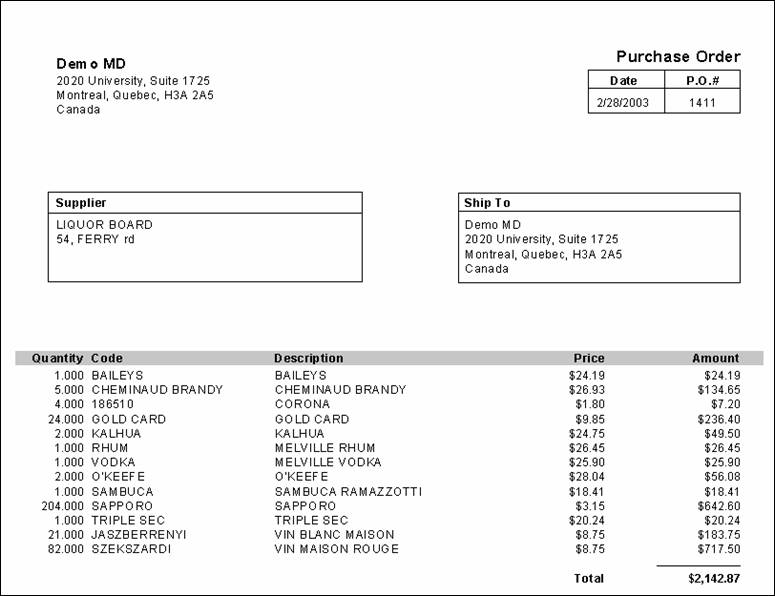
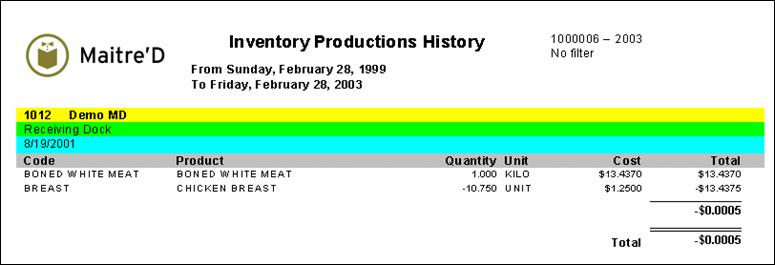
Maitre'D's purchase report shows you in graphics and numbers how the purchases affected the inventory quantities by suppliers and by locations. From the report filter window, select the dates, suppliers, locations, items, categories and groups to be included in the report. The following is a sample of the purchase report:
For each location, this report is divided in two sections. The first section provides you with:
Product:
Inventory item description.
Category:
Category this inventory item belongs to.
Quantity:
Number of inventory items purchased.
Unit:
Inventory format
Cost:
Price worth per inventory format.
Total:
Total value of the purchase.
Date:
Date the purchase occurred.
Check #:
Invoice number indicated on the supplier invoice.
For each location, the second section provides you with:
Supplier:
Name of the supplier.
Quantity:
Number of inventory items purchased.
Total:
Total value of the purchases.
Maitre'D's Inventory Report is one of the most interesting reports you can generate from the inventory system. This report shows, for each inventory item, information such as beginning stock, purchases, transfers, sales, losses, ending stock, variance, value, operating cost and turn over for the time period requested. This report is available on daily, weekly, period and monthly basis. From the report filter window, select the appropriate period, suppliers, inventory items, categories, groups, locations and departments to be included in the report.
Inventory Report Sample
Restaurant name (in the yellow bar)
The restaurant code as well as the restaurant name is displayed.
Location (in the green bar)
The report is divided by inventory location within the restaurant. If there is only one location, the green bar will say “Default location”. Otherwise, the name of each location will appear in the report.
Category (In the magenta bar)
Category this inventory item belongs to.
Product
Description of the inventory item.
Units
Inventory format the item is counted in.
Beginning Stock
Quantity of inventory item in stock at the beginning of the selected period.
Purchases
Quantity of items purchased in the selected period
Transfer
Quantity of items transferred to or from other locations within the restaurant
Sales
Quantity of inventory items used as the result of sales
Losses
Quantity of inventory items wasted
Ending stock
Quantity of inventory item in stock at the end of the selected period.
Variance
Variation of the stock quantity that cannot be explained by sales or wastage, calculated after a physical inventory count.
Value
Total value of the remaining stock.
Operation cost
Total value of stock lost due to wastage and negative variance.
Turnover
Average number of days that an item remains in stock before being used.
NOTE: This report is sorted alphabetically by Inventory Categories, and then each category is sorted alphabetically by Inventory Item Description.
If a specific moment is chosen, such as This Morning or Now, the report will show less information.
Inventory Report Sample (Specific moment)
Code
Code of the inventory item.
Product
Description of the inventory item.
Category (In the magenta bar)
Category this inventory item belongs to.
Site
Physical site where the item is located.
Stock
Quantity of inventory item in stock.
Format
Inventory format the item is counted in.
Cost
Cost of inventory item per inventory unit.
Total
Total cost of inventory item for the quantity in stock.
Adjustment
Last date a quantity adjustment was made on that item.
Supplier
Name of current supplier of the inventory item.
NOTE: This report is sorted alphabetically by Inventory Categories, and then each category is sorted alphabetically by Inventory Item Description.
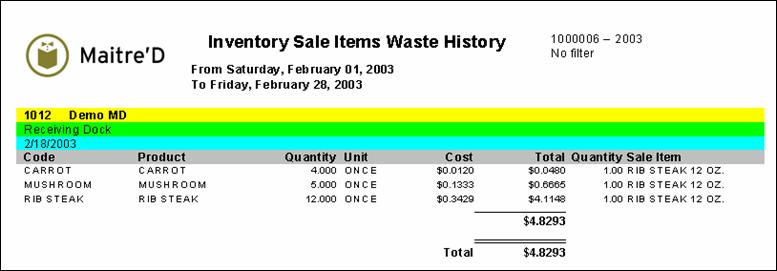
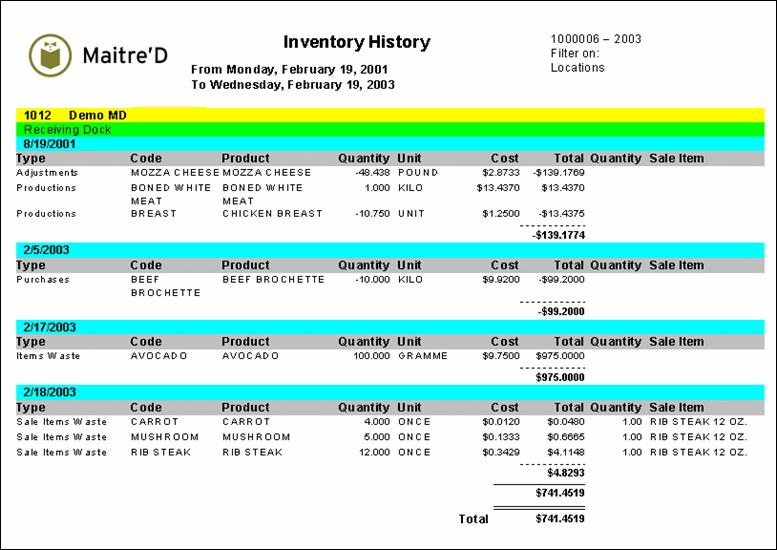

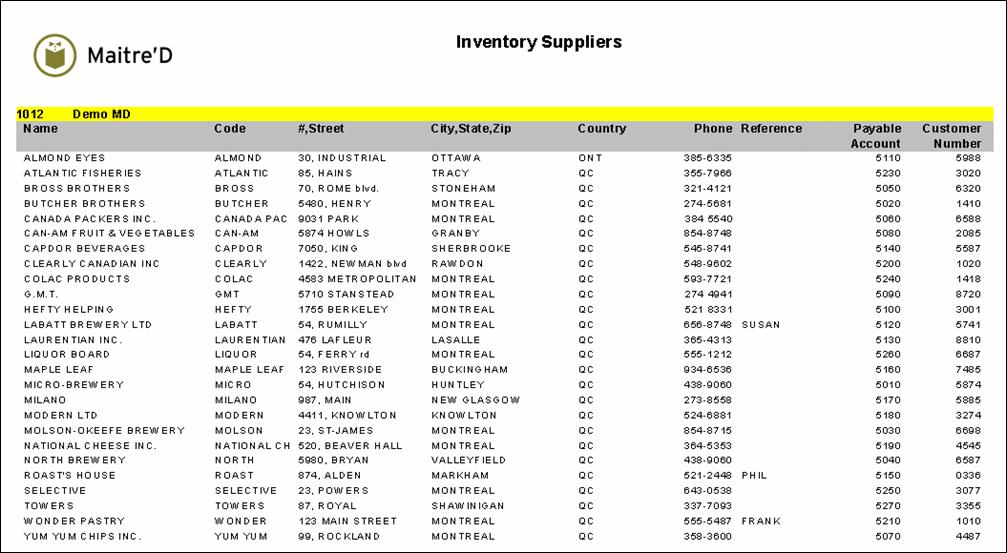
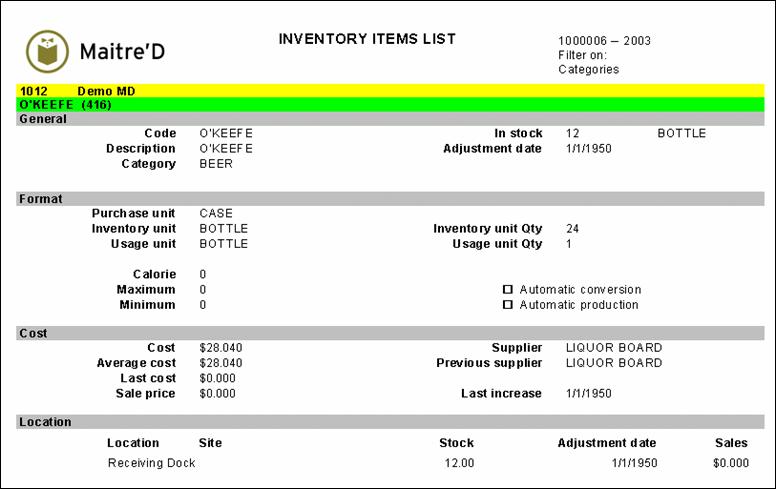



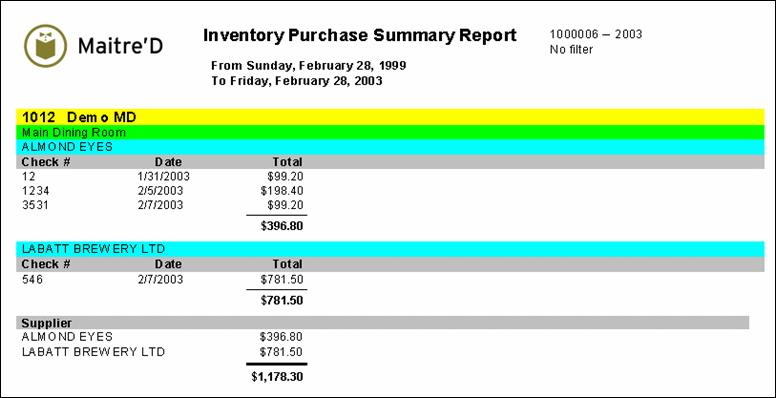
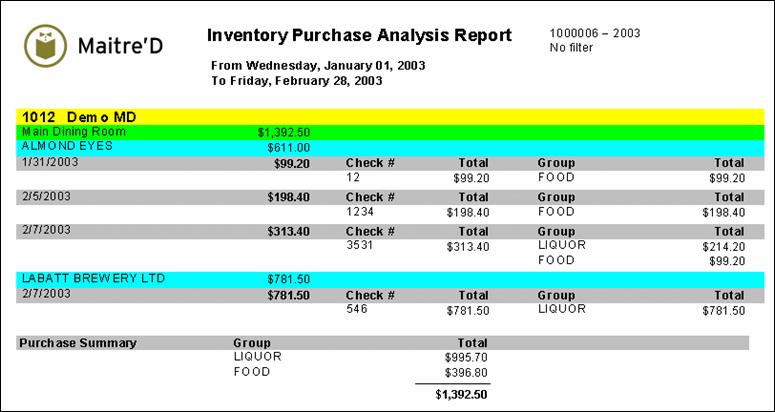


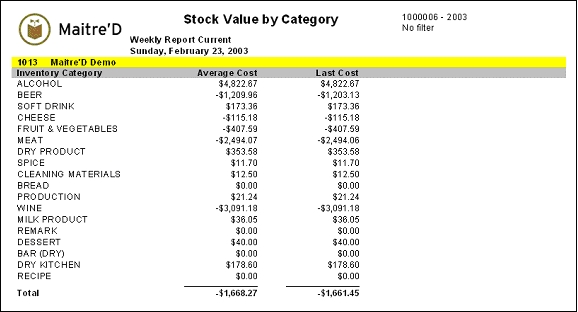
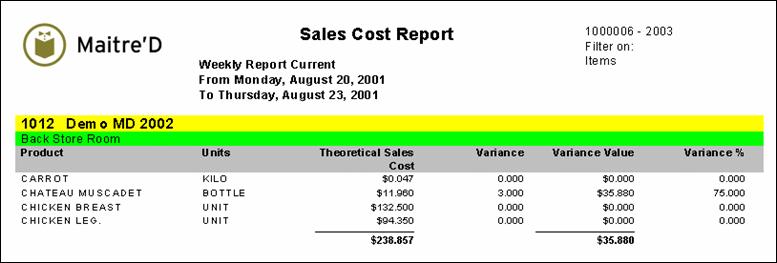
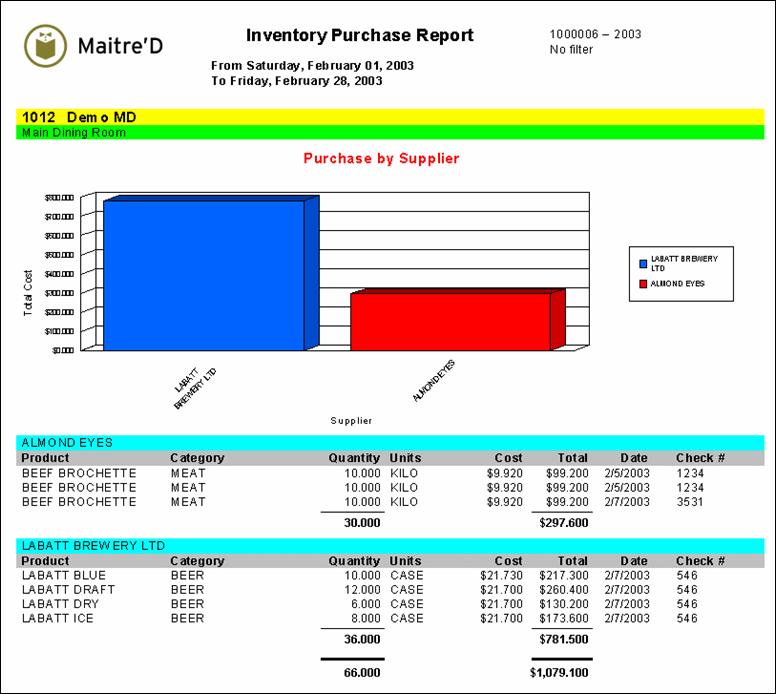
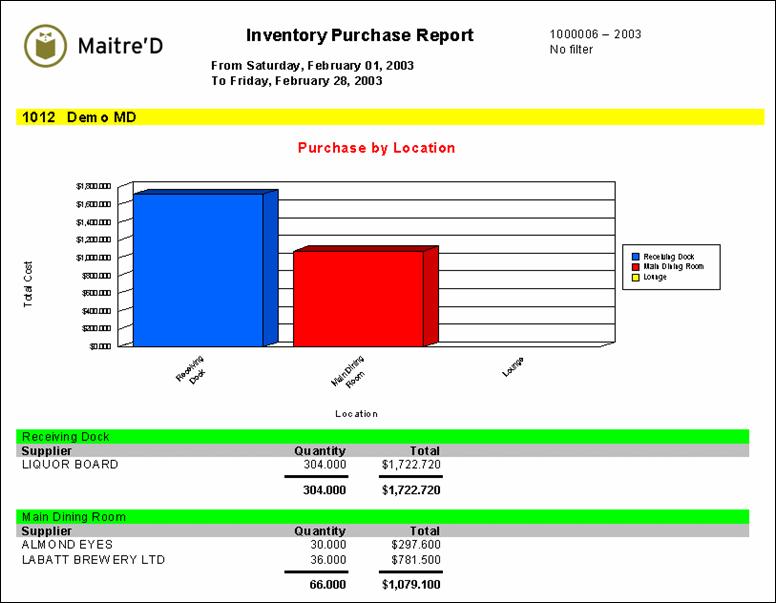



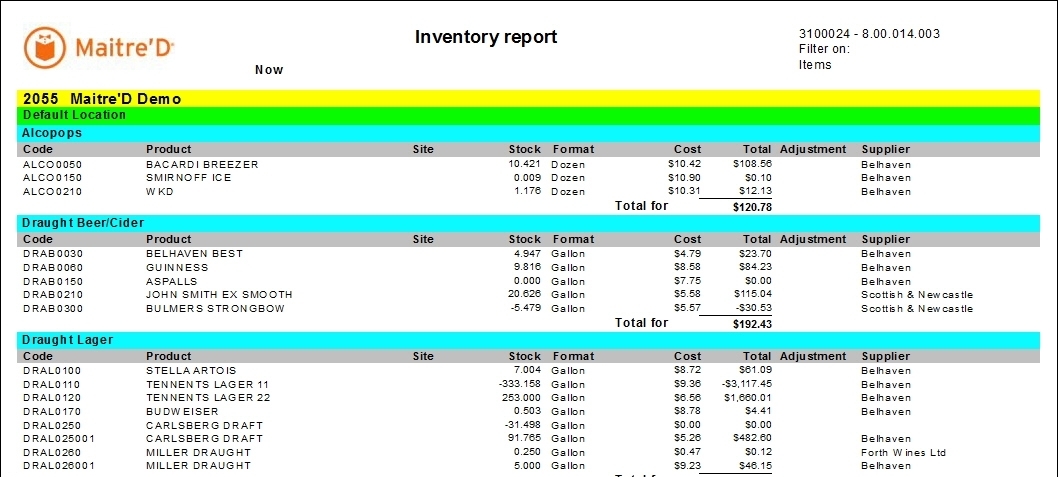
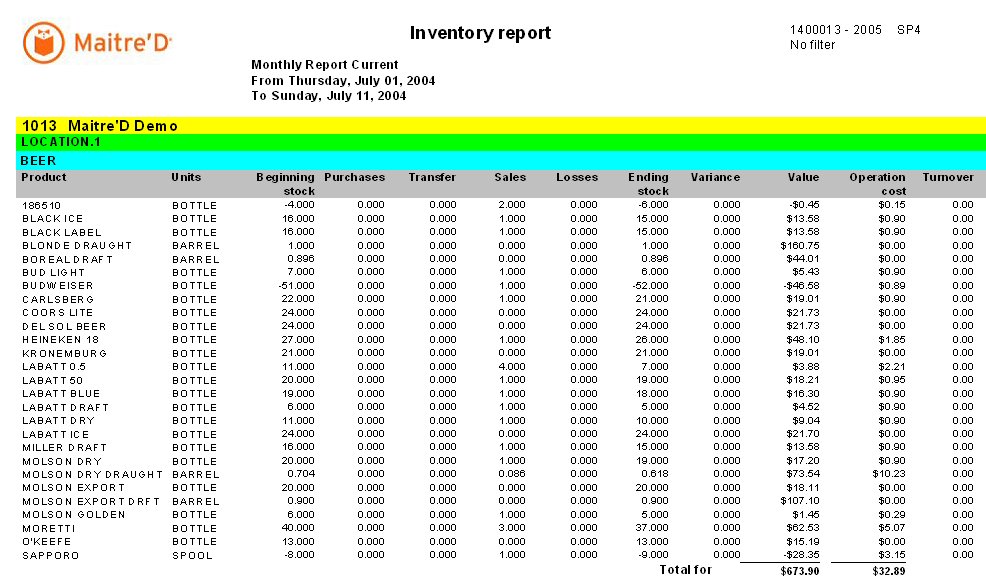
Maitre'D's Variances Report shows inventory variances. The variance is the difference between the theoretic and real quantity used according to your inventory adjustment. This report is available on weekly, periodic and monthly basis. From the report filter window, select the appropriate period, suppliers, inventory items, categories, groups, locations, departments and amounts to be included in the report. The following is a sample of the variances report:
Product:
Description of the inventory item.
Units:
Format the item is used in recipes.
Purchases:
Quantity of inventory item, in usage units, purchased during the time period.
Real Used:
Theoretical Used:
Quantity of inventory item sold, in usage units.
Variance:
Real used minus theoretical used.
Real Cost:
Theoretical cost plus variance cost.
Theoretical Cost:
Total cost of inventory item sold.
Variance:
Total variance cost value of inventory item variation.

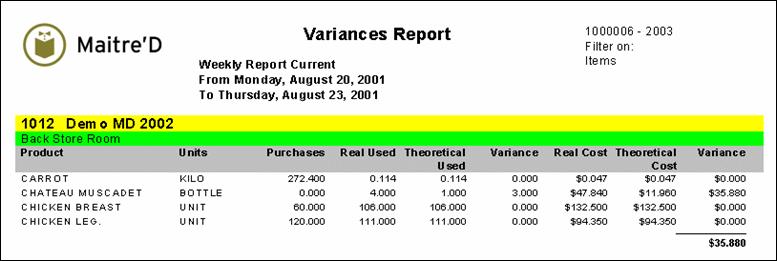
Maitre'D's billing check report allows to print a previously created billing check so it can be mailed or faxed to the customers. From the report filter window, select the dates and customers to be included in the report, as well as whether or not to include inactive accounts. The following is a sample of the billing check report:
This report is divided in two sections. The first section provides you with:
>Restaurant address
Address of the restaurant where this bill is coming from.
>Invoice Number
Bill sequential number.
Date issue:
Date of creation of the bill.
Billing address:
Address where the bill will be shipped.
The second section provides you with:
Quantity:
Quantity of inventory items ordered.
Format:
Purchase format.
Description:
Inventory item description.
Price:
Price charged by purchase format.
Extension:
Total amount for this inventory item.
The third section provides you with:
Sub-Total:
Total amount for all inventory items on the bill.
Tax1:
First tax charged on the inventory items.
Tax2:
Second tax charged on the inventory items.
Amount:
Total amount billed, including taxes.
